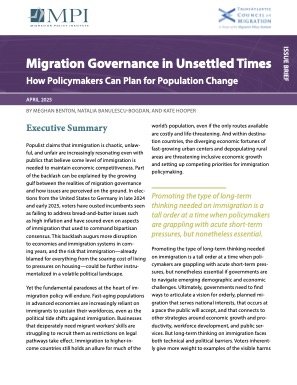By Matthew Lisiecki, Kevin Velasco, and Tara Watson
The Trump administration has begun to carry out activities connected to its campaign promise of a nationwide mass deportation program for undocumented immigrants. What will this mean for the estimated 5.62 million U.S. citizen children with an undocumented household member, and for the state and local child welfare systems charged with protecting their safety and well-being?
Changes in immigration enforcement policy
In fiscal years 2021 through 2024, Immigrations and Customs Enforcement (ICE) arrested around 125,000 immigrants in the nation’s interior each year and deported an average of 38,000. These numbers were lower than during the first Trump administration, which in turn were lower than during Obama’s first term.
Under Biden, immigrants most often came to the attention of ICE through the criminal justice system because they were already in custody of local law enforcement. Fewer than half were “at large” arrests in the community, meaning enforcement activity was mainly focused on those in contact with local jails and prisons. In addition to a more aggressive border stance, the Trump administration has signaled its intention to ramp up and broaden interior enforcement.
In his first term, Trump slightly increased enforcement, but the bigger change was making it more chaotic and unpredictable. This pattern appears to be resuming in 2025. The administration has revoked the sensitive locations guidance that previously prevented enforcement activity in hospitals, schools, and churches, with legal challenges underway. It has expanded expedited removal for migrants who recently crossed the border—which bypasses the usual legal process for undocumented residents—to include anyone arriving in the last two years encountered anywhere in the United States. The recently passed Laken Riley bill requires the detention of any undocumented person charged with certain crimes, even if not convicted, including crimes as trivial as shoplifting. The administration has also amplified efforts to involve state and local law enforcement through the 287(g) program, and has shifted priorities across federal agencies such as the Internal Revenue Service (IRS) and the Drug Enforcement Administration (DEA) away from their usual work toward immigration enforcement. And in mid-March Trump invoked the Alien Enemies Act, which is contested in court but would allow deportations of Venezuelans without the usual due process protections.
It is too early to know how much the numbers of arrests and deportations will increase. Certainly, the administration may fall short of its stated goal of deporting all undocumented immigrants, but between enforcement activities already underway and immigrants faced with no good options electing to leave the country—so-called “self-deportation”—the level of enforcement will be significant from an economic and humanitarian perspective. There will also be chilling effects on activities including free speech, appearing in public, seeking medical care, and going to work as immigrant communities struggle to make sense of the new policy environment.
Washington, DC: Brookings, 2025. 16p.





















